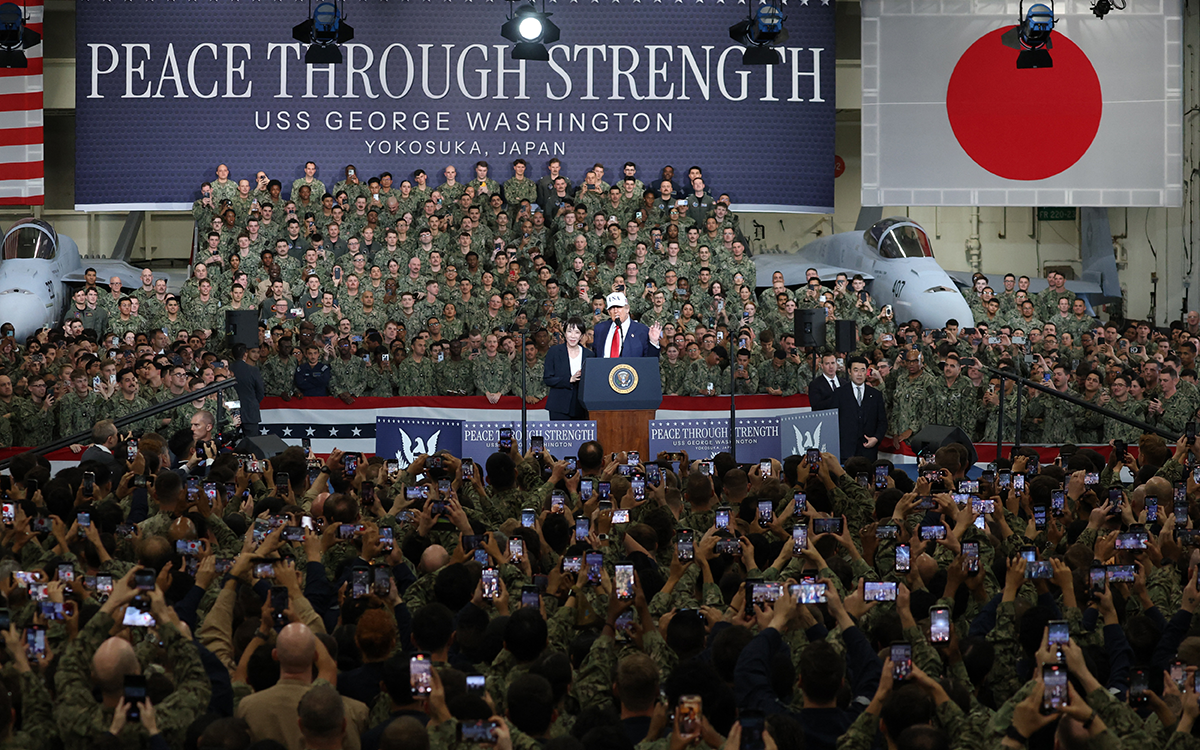


US President Donald Trump just completed his most significant foreign trip of the year. His week-long sojourn in Asia provided opportunities to augment ties with new allied leaders, underscore the enduring US regional presence to wavering partners, and manage tensions while reinforcing deterrence against China. The first goal was broadly achieved, the second was partly realized, but the meeting with PRC President Xi Jinping was anticlimactic, resulting in a fragile ceasefire and de-escalation agreement that left critical questions unresolved.
The article focuses on the trip’s security developments rather than the economic elements. Last week’s commercial deals often confirmed agreements reached earlier, whereas several security outcomes were genuinely novel. The text first assesses how well Washington advanced its goals with key actors. Next, it speculates how developments could shape the region’s power balances and strategic alignments.
The joint declaration between Cambodia and Thailand was the main security deliverable of Trump’s excursion to the Association of Southeast Asian Nations (ASEAN) summit in Malaysia. The new de-escalation accord furthered their earlier ceasefire to initiate demilitarization, demining, prisoner releases, ceasefire monitoring teams, and troop and weapons withdrawals. These measures, while not resolving competing territorial claims, should encourage more displaced people to return to border villages.
Since the export-dependent ASEAN economies rely heavily on foreign trade and investment, Trump leveraged the two governments’ desire to limit US tariff hikes to induce concessions. As a reward, Cambodia and Thailand each received a bilateral trade deal with the United States. US diplomats reportedly insisted on the signing ceremony to secure Trump’s attendance at the summit. Even so, transforming the ceasefire into an enduring peace deal will require continued US engagement and other benign developments to succeed.
Trump leveraged the Cambodian and Thai governments’ desire to limit US tariff hikes to induce concessions
Though he stayed for only 24 hours, Trump earned points for simply showing up. ASEAN representatives routinely complain that the United States neglects Southeast Asia. Trump used the opportunity to meet many Southeast Asian leaders and sign several bilateral trade and critical minerals agreements. However, securing Washington’s attention will require ASEAN to become more influential. Its members remain divided over the Myanmar civil war, Beijing’s territorial claims, and other collective challenges.

Trump’s visit to Japan was arguably the most impactful leg of his trip due to the country’s economic and military importance and its new political leadership. Japan hosts some 50,000 US troops and plans to join the Pentagon in third-party contingencies, including those involving Taiwan.
The new Prime Minister Sanae Takaichi affirmed the imperative of strengthening joint defense capabilities, given the “unprecedented” regional security threats. Takaichi was close to former Prime Minister Shinzo Abe, one of Trump’s closest foreign associates during his first term. She adroitly wrapped herself in Abe’s memory, using his “Free and Open Pacific” phraseology and gifting Trump one of Abe’s putters. Takaichi announced her government would reach its two percent GDP defense spending goal two years earlier than planned, which would accelerate purchases of US weapons.
Japan looks to remain Trump’s Asian favorite. He welcomed these arms sales and capability enhancements. In turn, Trump pledged that the United States would remain an “ally of the highest level.” The two governments signed a statement affirming their alliance had entered a “New Golden Age.”
During his subsequent visit to the Republic of Korea (ROK), Trump signed important agreements with the host government and engaged with visiting leaders attending the annual Asia-Pacific Economic Cooperation (APEC) summit in Gyeongju.
The finalization of the ROK-US trade and investment agreement was widely anticipated; however, the US decision to help South Korea acquire a nuclear-powered submarine and manufacture its own nuclear fuel was a novel development. Though not matching the North’s nuclear weapons capabilities, these advancements substantially bolster the ROK’s conventional deterrent against North Korea and elevate the South’s status as a privileged US ally.
ROK President Lee Jae-myung welcomed the summit and Trump’s presence as manifestations that South Korea was back on the world stage following its recent political chaos. Still, ROK-US ties will remain more fragile than Japanese-US relations under Trump. Unlike Takaichi, Lee is not ideologically aligned with Trump and is more cautious about confronting China.
In his later meeting with Xi, Lee requested that China leverage its ties with North Korea to induce Pyongyang to reengage diplomatically with the South. If Beijing orchestrates an intra-Korean detente, China could return to the center of South Korean diplomacy, potentially alienating the United States.
If Beijing orchestrates an intra-Korean detente, China could return to the center of South Korean diplomacy, potentially alienating the United States
The US administration orchestrated Trump’s itinerary to enhance his leverage for his first in-person meeting with the PRC president in six years. For example, the United States secured several critical mineral agreements with Asian partners. Trump’s perplexing Truth Social post, made immediately before his meeting with Xi, about resuming US nuclear testing probably reflected his irritation at recent high-profile Russian tests of advanced strategic delivery vehicles. It was also likely aimed at Xi to remind him of US military power and spur Chinese-US nuclear arms talks. However, the Xi-Trump side meeting lasted only around 90 minutes and left many important questions unanswered.
The most concrete results were mutual de-escalation regarding tariffs, PRC pledges regarding fentanyl, and relaxation of export controls on semiconductors and rare earth minerals. China also agreed to resume importing US soybeans and possibly US energy. In the past, such verbal commitments were only partially implemented. Furthermore, the deal over TikTok and the hoped-for nuclear arms talks remained elusive. The dialogue on sensitive security issues such as Iran, Ukraine, Afghanistan, North Korea, and Taiwan was cursory or nonexistent. These disappointing results reinforced prevailing regional perceptions that Washington and Beijing remain locked in a structural rivalry despite occasional tactical pauses.
However, Secretary of Defense (War) Pete Hegseth, though traveling separately, benefited from Trump’s coattails to engage in several high-level defense dialogues with senior Asian officials. His meeting with the PRC defense minister, though contentious, reopened military communication channels. This was an opportune development given China’s military buildup and its leadership turnover due to Xi’s purges.
Trump and Xi can more comprehensively address these issues if the planned reciprocal presidential visits occur next year. These trips will provide days rather than hours for direct presidential dialogue. Given the breadth and depth of Sino-US tensions, only Trump and Xi have the authority to force a settlement within their political systems.
Trump’s well-crafted itinerary reinforced the strategic narrative of sustained US leadership in the Pacific. The high-profile trade deals allowed him to justify his controversial tariff policies as advancing US commercial interests. In his view, the pageantry and praise he received reinforced his diplomatic authority. The trip also allowed Trump to distance himself from the political chaos in Washington. Importantly, Trump eschewed the easy political gains he might have accrued by compromising on US security partnerships or export controls in exchange for more PRC purchases from Republican-leaning business interests.
The trip illustrated that Trump’s second-term policies differ from those of his first presidency. Following early setbacks, his rhetoric and understanding of the value of US alliances have become more refined, while his agenda regarding China has moderated and narrowed. Additionally, Trump has relied more on wide-impact tariffs rather than targeted sanctions, which are easier to circumvent and harder to repeal. Trump still prioritizes commercial deals, but with a greater focus on securing inbound foreign direct investment and access to critical minerals. Of course, there are substantial continuities between the two Trump presidencies, such as Trump’s penchant for personal diplomacy with his foreign counterparts.
Following early setbacks, his rhetoric and understanding of the value of US alliances have become more refined, while his agenda regarding China has moderated and narrowed
The economic issues that permeated Trump’s trip will remain perennial problems. The critical minerals deals will take years to execute, given the challenges of launching new projects. Until Washington can regain more leverage over Beijing, China will exploit this capacity shortfall to challenge future US policies. But the range of potential security outcomes in the next few years is more variable.

Trump appears to have dispelled concerns that his administration will soon abandon allies or appease adversaries. Worries that the United States would withdraw troops from the region or sell out Taiwan for soybean exports proved mistaken.
Conversely, the new governments in Japan and South Korea remain committed to enhancing their security partnerships with the United States and each other. Both are developing new military capabilities that could enhance regional deterrence in league with Washington. If fully implemented, the recent US security agreements with these and other US allies and partners will strengthen the alliance network in Asia and discourage PRC military provocations. If Beijing remains assertive, this trilateral cooperation could evolve into a semi-formal security bloc.
Nonetheless, the Trump administration may not prevent commercial disputes from upending its security collaboration with allies and partners. Meanwhile, the PRC leadership is steadily enveloping these states within its economic and diplomatic networks, laying the groundwork for subordinating their foreign policies to Chinese leadership.
After Trump departed before the main APEC conference began, Xi deftly exploited his first visit to South Korea in over a decade to connect with governments alienated from Beijing. Now that China has assumed the annual leadership of APEC (whose members encompass over half the world’s GDP) and developed new coercive tools, the PRC will be even better positioned to shape the regional agenda and exploit US-allied economic tensions for security gains.
Now that China has assumed the annual leadership of APEC, the PRC will be even better positioned to shape the regional agenda and exploit US-allied economic tensions for security gains
Unlike other Asian governments, China retaliated against US trade restrictions rather than make unilateral concessions to avert even worse outcomes. Having won at least a draw in the recent commercial confrontation and developed new tools to apply against the United States, Beijing could well behave more aggressively in future Sino-US conflicts, even as both parties decrease their mutual dependencies.
If PRC policymakers try to seize Taiwan by force, it would place unprecedented strains on US regional alliances. The most important objective of the Japan-US defense treaty has become less about the defense of Japan against a direct external attack and more about the two countries’ protection of Taiwan. Though this presently acts as an alliance pillar, it could also represent a point of vulnerability should the US fail to meet Japanese expectations regarding the defense of Taiwan. Similarly, the ROK-US alliance might not survive a Taiwan conflict in which Seoul refuses to render Washington and Tokyo indispensable support.
Overall, Trump’s Asia trip exemplified both the strength and weakness of US influence in a part of the globe where diplomacy and deterrence must be combined.